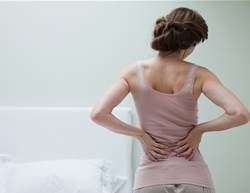No two breasts (not even your own!) are identical in shape, size, or feel. But it’s important to pay attention to what makes each one of yours unique so you can spot peculiarities early and start conversations with your doctor if need be.
Consider this your friendly guide to what changes to expect through the years and what to do if something feels or looks unusual so you can take steps toward better breast health and prevent breast cancer.
Why do my breasts feel different to before?
Breasts respond to hormonal changes throughout the month and all through your life. “When you’re young, the breasts feel firm and dense because there’s more connective tissue and less fatty tissue,” says breast surgeon and oncologist Dr Teralyn Carter. “But as we age there’s less glandular tissue and more fat, so they may feel softer.”
They may also feel more, well, stretched out, because as time passes the connective tissue that holds their weight loses elasticity and breasts may become more pendulous, especially after menopause, at which point breasts are mostly fat.
Women on menopausal hormone therapy (MHT), however, tend to have more glandular tissue, so their breasts still may feel firm. And if you still menstruate, you may notice that your breasts become swollen or tender before your period each month. During pregnancy, breast enlargement and tenderness as well as nipple darkening and leakage are totally normal.
The takeaway: The truth is, people’s breasts change differently over time, and there’s not one specific pattern as to how, Dr Carter says. Get to know what’s normal for your body, and if you feel something unusual at any time, talk to your doctor. “You know your breasts better than anyone else,” says Dr Carter.
What changes should I look out for?
You should check your breast regularly for changes. This is what to look out for, reports Cancer Council NSW:
- A new lump or lumpiness
- A change in the size or shape of the breast
- A change to the nipple, such as crusting, ulcers or sores, redness or inversion
- A clear or bloody discharge from the nipple that occurs without squeezing
- A change in the skin of the breast, such as redness or dimpling
- Swelling or discomfort in the armpit
If you do notice any of these changes, see your GP for a check up.
I have dense breasts. Should I be worried?
Breast density is a measure of how much glandular and connective tissue versus fatty tissue you have, says breast cancer expert Dr Sandhya Pruthi. “But the concern is that dense breasts look white on a mammogram, making it harder to read because cancers also show up as white masses.”
Having extremely dense breast tissue does mean, however, that you have a higher risk of developing breast cancer compared with people whose breast tissue looks primarily fatty on a mammogram, says Dr Pruthi, though researchers aren’t exactly sure why. The reason may be genetic, or it may be due to the use of hormones that can increase breast density or to something else. But don’t worry: breast density isn’t related to breast cancer survival.
The takeaway: Breast density (rated from A to D, with D being extremely dense) is not an illness. Still, having dense breasts means you should have a conversation with your doctor about whether additional imaging beyond a mammogram, such as an ultrasound or an MRI, may be recommended, says Dr Pruthi.
Also, talk to your doctor about having a breast cancer risk assessment—they will consider factors including breast density, the age at which you had your first period, how many biological children you’ve had, your family history, and the results of prior breast biopsies.
Your mammogram will tell you if you have dense breasts. Ask your doctor to read the report and ask them whether additional screening is recommended.
Is going braless bad for you?
Your grandma might have told you that ditching your bras would accelerate the loss of elasticity that comes with age or affect your risk of developing breast cancer. Fortunately, she was wrong about both.
“There’s no data to support the use or non-use of bras,” says gynaecologist Dr Yvette LaCoursiere. “Many women feel better and more supported in a bra, especially during exercise, but there’s no medical reason to wear one.”
For some women, going braless is painful. “If you feel a pulling or aching when you take your bra off, especially if you have large breasts, go ahead and wear one if it relieves the discomfort,” says Dr Carter. It’s also fine to wear a bra to bed if that feels more comfortable.
The takeaway: Whether you wear a bra or not is entirely up to you, says Dr Carter. If you do wear one, make sure to find one that isn’t tight and doesn’t dig in and chafe, which can lead to issues such as nerve pain and rashes. Read about figuring out your bra size.
Can all women breastfeed?
Breastfeeding isn’t always an option. “There can be many reasons you can’t breastfeed,” says Dr Carter. For example, you may have had a mastectomy, have a premature baby who finds it hard to latch on, struggle with low supply or postpartum depression, or have a job that makes breastfeeding or pumping very difficult or impossible.
“I tell mums that a fed baby is a healthy baby—it doesn’t matter how you feed them,” says Dr Carter. While lactation consultants can help with issues such as clogged milk ducts, sore nipples, a bad latch, and difficulty pumping, sometimes breastfeeding is not an option.
That said, the benefits of doing so for both baby and mother are well documented; it’s ideal if you can breastfeed for six months, says Dr Carter. Babies who breastfeed receive antibodies from breast milk that help them develop strong immune systems, and they have a lower risk of ear infections, asthma, obesity, type 1 diabetes, and sudden infant death syndrome. Moms who breastfeed have a lower risk of high blood pressure and type 2 diabetes as well as breast and ovarian cancer.
The takeaway: There are numerous advantages to breastfeeding, but circumstances may prevent a woman from breastfeeding, and she shouldn’t feel like a bad mum if she can’t or chooses not to.
“A woman should be able to make her own health care choices,” says Dr LaCoursiere. “As long as you understand the risks and benefits, it’s your choice. Breastfeeding doesn’t define you as a mum.”
When should I get a mammogram?
Women aged 50 to 74 to are recommended to have a free mammogram every two years, says Breast Screen Australia. Women aged 40 can also get a free mammogram every two years if their doctor recommends it, for example if they have a family history of breast cancer.
Your breasts may be tender when you have your period, which could make the mammogram more uncomfortable—do it a week after your period instead.
Can I get a mammogram with breast implants?
You can. If you have implants, you will have additional images taken with the implants pushed back against the chest wall.
Are my nipples a weird colour?
Nipples are not all the same colour. It’s normal for nipples to range from pink to dark brown depending on a person’s pigmentation. But they may darken when someone becomes pregnant, or they may become paler (with the areolae also fading) with age.









